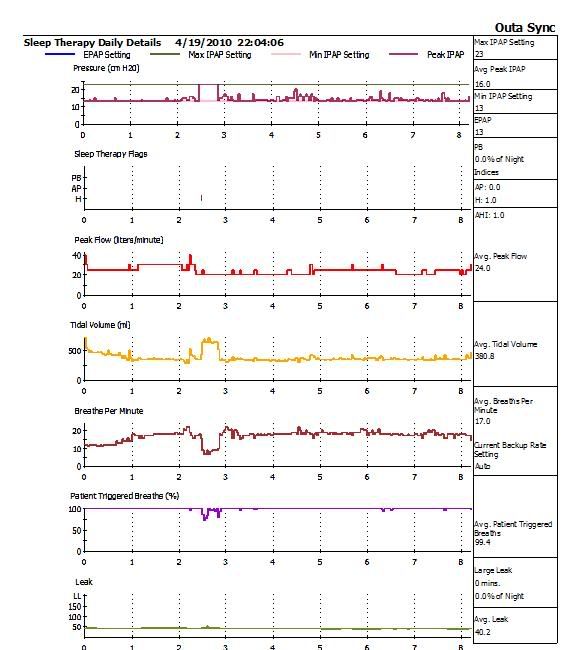
What happened here? SV Report
What happened here? SV Report
I just pulled up my reports from this week. What do you think happened here, between hours 2 and 3?


Diagnosed 9/4/07
Sleep Study Titrated to 19 cm H2O
Rotating between Activa and Softgel
11/2/07 RemStar M Series Auto with AFlex 14-17
10/17/08 BiPAP Auto SV 13/13-23, BPM Auto, AHI avg <1
Sleep Study Titrated to 19 cm H2O
Rotating between Activa and Softgel
11/2/07 RemStar M Series Auto with AFlex 14-17
10/17/08 BiPAP Auto SV 13/13-23, BPM Auto, AHI avg <1
Re: What happened here? SV Report
Bev
looks like it was triggered by the leak (see the leak data graph).
I see there was a preceding leak which may have skewed the average peak flow data that the machine relies on.
On the other hand, the leak could have been triggered by the pressure ramping to max PS as shown in the top graph.
But, the fact that your BPM dropped at this same time suggests there was no hyperventilation occurring but your tidal
volume has also jumped markedly at this same time (which contradicts the low BPM) & reinforces the leak theory as
the cause. Also during that event, the machine basically took over control of your breathing.
The other aspect that seems odd is that the leak is not what I consider a big one ?, again it may have been a case
of the preceding leak skewing the av peak flow data & causing the machine to ramp up pressure excessively.
Interestingly, your events data shows a very good night. I used to find this often with my Bipap Auto SV, that the
data looked perfect but I had not had what I would call a good day after it.
DSM
looks like it was triggered by the leak (see the leak data graph).
I see there was a preceding leak which may have skewed the average peak flow data that the machine relies on.
On the other hand, the leak could have been triggered by the pressure ramping to max PS as shown in the top graph.
But, the fact that your BPM dropped at this same time suggests there was no hyperventilation occurring but your tidal
volume has also jumped markedly at this same time (which contradicts the low BPM) & reinforces the leak theory as
the cause. Also during that event, the machine basically took over control of your breathing.
The other aspect that seems odd is that the leak is not what I consider a big one ?, again it may have been a case
of the preceding leak skewing the av peak flow data & causing the machine to ramp up pressure excessively.
Interestingly, your events data shows a very good night. I used to find this often with my Bipap Auto SV, that the
data looked perfect but I had not had what I would call a good day after it.
DSM
Last edited by dsm on Sat Apr 24, 2010 9:08 pm, edited 1 time in total.
xPAP and Quattro std mask (plus a pad-a-cheek anti-leak strap)
Re: What happened here? SV Report
Bev, can you think of any possible exacerbating factors that might have contributed?
Late night food/beverages that might have triggered a humdinger acid reflux flareup? Unusual stress factors? Agitated wakefulness or dreams that time of night?
How are heart rate and blood pressure doing lately? How is SpO2 doing lately as well?
Late night food/beverages that might have triggered a humdinger acid reflux flareup? Unusual stress factors? Agitated wakefulness or dreams that time of night?
How are heart rate and blood pressure doing lately? How is SpO2 doing lately as well?
Re: What happened here? SV Report
-SWS,
I can't think of anything unusual happening that night. Since my last ER visit in November with chest pain, high blood pressure and rapid heart beat, my doctor had upped my Prilosec to 2 times a day and added reglan (30 minutes before each meal). If I remember to take the reglan, I do pretty well. If I forget to take it, and I don't remember if I took it before Monday's dinner, I have chest pain and feel pretty miserable. I haven't checked my oxygen levels in over a year, because my numbers always look good and I hate to wear that finger clip. My stress level has been pretty high.
DSM,
I've been using the SV for a year and a half and have never seen it act this way, even though I have the occasional leak, it usually wakes me up, I adjust the mask and go right back to sleep. I don't recall waking up with leaks on that particular night. I always feel terrible in the morning and struggle to wake up, so nothing different there.
Bev
I can't think of anything unusual happening that night. Since my last ER visit in November with chest pain, high blood pressure and rapid heart beat, my doctor had upped my Prilosec to 2 times a day and added reglan (30 minutes before each meal). If I remember to take the reglan, I do pretty well. If I forget to take it, and I don't remember if I took it before Monday's dinner, I have chest pain and feel pretty miserable. I haven't checked my oxygen levels in over a year, because my numbers always look good and I hate to wear that finger clip. My stress level has been pretty high.
DSM,
I've been using the SV for a year and a half and have never seen it act this way, even though I have the occasional leak, it usually wakes me up, I adjust the mask and go right back to sleep. I don't recall waking up with leaks on that particular night. I always feel terrible in the morning and struggle to wake up, so nothing different there.
Bev
Diagnosed 9/4/07
Sleep Study Titrated to 19 cm H2O
Rotating between Activa and Softgel
11/2/07 RemStar M Series Auto with AFlex 14-17
10/17/08 BiPAP Auto SV 13/13-23, BPM Auto, AHI avg <1
Sleep Study Titrated to 19 cm H2O
Rotating between Activa and Softgel
11/2/07 RemStar M Series Auto with AFlex 14-17
10/17/08 BiPAP Auto SV 13/13-23, BPM Auto, AHI avg <1
Re: What happened here? SV Report
Well, I don't think it's leak related, since the leak is practically negligible during that segment. Nor do I think it's a data reporting glitch, since four separate graphical data lines are all on the same sheet of music, so to speak---some being machine-response measurements and some being independent measurements of biological parameters.
That peak flow (in liters per minute) line is specifically what your machine targets----by fluctuating IPAP peak. As a side note, that same peak-flow line (in liters per minute) is the Respironics time-based near equivalent of "minute volume" on the Resmed ASV model.
Accordingly you'll notice that:
1) As your breath rate becomes latent and reflected in lower BPM machine measurements:
2) a heavier reliance on machine backup rate becomes necessary, and:
3) IPAP peak must also algorithmically ramp up in order to:
4) deliver much larger per-breath or tidal volumes to keep your peak-flow up where it needs to be, according to recent-average targeting (liters per minute volume)
Recall that a tidal volume is a per-breath volume. So you and your machine can accomplish the same targeted peak-flow (or liters per-minute volume) with: a) a lower-BPM paired with higher tidal-volume, or b) a higher-BPM paired with lower tidal-volume. Either scenario can yield the same targeted peak flow number (as can a gradient of inversely-proportional paired combinations in between).
So when/if your breathing slows down like it did in that graph, the machine is going to have to spike IPAP peak to get your tidal volumes up there----in order to meet your peak flow target. The machine's backup rate will increasingly kick in as well.
P.S. I'd suggest putting the recording oximeter on just to take a curiosity peek at your pulse graph.
That peak flow (in liters per minute) line is specifically what your machine targets----by fluctuating IPAP peak. As a side note, that same peak-flow line (in liters per minute) is the Respironics time-based near equivalent of "minute volume" on the Resmed ASV model.
Accordingly you'll notice that:
1) As your breath rate becomes latent and reflected in lower BPM machine measurements:
2) a heavier reliance on machine backup rate becomes necessary, and:
3) IPAP peak must also algorithmically ramp up in order to:
4) deliver much larger per-breath or tidal volumes to keep your peak-flow up where it needs to be, according to recent-average targeting (liters per minute volume)
Recall that a tidal volume is a per-breath volume. So you and your machine can accomplish the same targeted peak-flow (or liters per-minute volume) with: a) a lower-BPM paired with higher tidal-volume, or b) a higher-BPM paired with lower tidal-volume. Either scenario can yield the same targeted peak flow number (as can a gradient of inversely-proportional paired combinations in between).
So when/if your breathing slows down like it did in that graph, the machine is going to have to spike IPAP peak to get your tidal volumes up there----in order to meet your peak flow target. The machine's backup rate will increasingly kick in as well.
P.S. I'd suggest putting the recording oximeter on just to take a curiosity peek at your pulse graph.
Re: What happened here? SV Report
Some further thoughts ...
Re the tidal volume going up & BPM dropping. I can understand that in the sense that the machine is trying above all else to maintain the average peak flow - which can clearly be seen as the red graph. It is staying very average during that period in question.
The implication of that data is that the machine is trying to push you to take deep breaths either because you are starting to slow your breathing (and because of that, it must try to maintain the 4-min window of av peak flow) or because you stopped breathing & that might be deduced from the purple graph at the bottom which indicates the machine took control of your breathing because you weren't.
I think in the past you have mentioned stopping breathing ? - if so then that would be my best guess at what that particular data shows.
Also the questions SWS asked are very relevant if this was a sudden unusual episode of stopping breathing.
DSM
(an absolute amateur seeking to try to makes sense of complex data )
Re the tidal volume going up & BPM dropping. I can understand that in the sense that the machine is trying above all else to maintain the average peak flow - which can clearly be seen as the red graph. It is staying very average during that period in question.
The implication of that data is that the machine is trying to push you to take deep breaths either because you are starting to slow your breathing (and because of that, it must try to maintain the 4-min window of av peak flow) or because you stopped breathing & that might be deduced from the purple graph at the bottom which indicates the machine took control of your breathing because you weren't.
I think in the past you have mentioned stopping breathing ? - if so then that would be my best guess at what that particular data shows.
Also the questions SWS asked are very relevant if this was a sudden unusual episode of stopping breathing.
DSM
(an absolute amateur seeking to try to makes sense of complex data )
xPAP and Quattro std mask (plus a pad-a-cheek anti-leak strap)
Re: What happened here? SV Report
Since my nights have been pretty steady for the last year, what I am wondering is---if I had not had the SV, would I have died that night? It's important for me to know, because even if that happens only once a year, I want to have that back up. I've been taking just my APAP when I travel since it's so much easier to keep it packed and ready to go, but if I need to always have the SV, then I will have to start taking it.
Bev
Bev
Diagnosed 9/4/07
Sleep Study Titrated to 19 cm H2O
Rotating between Activa and Softgel
11/2/07 RemStar M Series Auto with AFlex 14-17
10/17/08 BiPAP Auto SV 13/13-23, BPM Auto, AHI avg <1
Sleep Study Titrated to 19 cm H2O
Rotating between Activa and Softgel
11/2/07 RemStar M Series Auto with AFlex 14-17
10/17/08 BiPAP Auto SV 13/13-23, BPM Auto, AHI avg <1
Re: What happened here? SV Report
Bev, we can't answer that for certain, but I personally doubt it. I think we have seen similar episodes (by other people) that were much more prolifically presented in ASV data reports. Some or all of those people would have experienced episodes prior to acquiring ASV therapy, and they clearly did not die. However, I suspect your ASV machine probably mitigated some unknown risk by maintaining your liters per minute target flow as nicely as it did for nearly half an hour.OutaSync wrote:...what I am wondering is---if I had not had the SV, would I have died that night?
Since the machine seemed to so nicely compensate your breathing for that approximate half-hour period, I think I'd be inclined to stick with the ASV if it were me.OutaSync wrote:It's important for me to know, because even if that happens only once a year, I want to have that back up. I've been taking just my APAP when I travel since it's so much easier to keep it packed and ready to go, but if I need to always have the SV, then I will have to start taking it.
Re: What happened here? SV Report
Back to looking for a back-up machine.
Diagnosed 9/4/07
Sleep Study Titrated to 19 cm H2O
Rotating between Activa and Softgel
11/2/07 RemStar M Series Auto with AFlex 14-17
10/17/08 BiPAP Auto SV 13/13-23, BPM Auto, AHI avg <1
Sleep Study Titrated to 19 cm H2O
Rotating between Activa and Softgel
11/2/07 RemStar M Series Auto with AFlex 14-17
10/17/08 BiPAP Auto SV 13/13-23, BPM Auto, AHI avg <1
Re: What happened here? SV Report
Bev, I'm so glad we have SWS around when we need him. Now I know you feel better and I do too.
_________________
| Mask: Mirage Quattro™ Full Face CPAP Mask with Headgear |
| Additional Comments: 14/8.4,PS=4, UMFF, 02@2L, |
"Do or Do Not-There Is No Try"-"Yoda"
"We are what we repeatedly do,so excellence
is not an act but a habit"-"Aristotle"
DEAR HUBBY BEGAN CPAP 9/2/08
"We are what we repeatedly do,so excellence
is not an act but a habit"-"Aristotle"
DEAR HUBBY BEGAN CPAP 9/2/08
Re: What happened here? SV Report
Dori, you are so right. -SWS has always been there for me, and I am truely grateful.
Bev
Bev
Diagnosed 9/4/07
Sleep Study Titrated to 19 cm H2O
Rotating between Activa and Softgel
11/2/07 RemStar M Series Auto with AFlex 14-17
10/17/08 BiPAP Auto SV 13/13-23, BPM Auto, AHI avg <1
Sleep Study Titrated to 19 cm H2O
Rotating between Activa and Softgel
11/2/07 RemStar M Series Auto with AFlex 14-17
10/17/08 BiPAP Auto SV 13/13-23, BPM Auto, AHI avg <1










